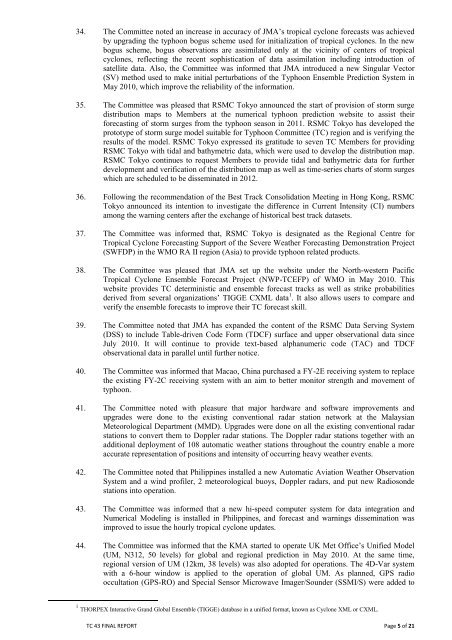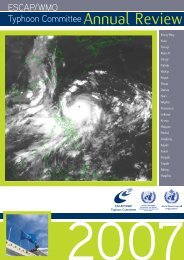1 - Typhoon Committee
1 - Typhoon Committee
1 - Typhoon Committee
Create successful ePaper yourself
Turn your PDF publications into a flip-book with our unique Google optimized e-Paper software.
34. The <strong>Committee</strong> noted an increase in accuracy of JMA’s tropical cyclone forecasts was achievedby upgrading the typhoon bogus scheme used for initialization of tropical cyclones. In the newbogus scheme, bogus observations are assimilated only at the vicinity of centers of tropicalcyclones, reflecting the recent sophistication of data assimilation including introduction ofsatellite data. Also, the <strong>Committee</strong> was informed that JMA introduced a new Singular Vector(SV) method used to make initial perturbations of the <strong>Typhoon</strong> Ensemble Prediction System inMay 2010, which improve the reliability of the information.35. The <strong>Committee</strong> was pleased that RSMC Tokyo announced the start of provision of storm surgedistribution maps to Members at the numerical typhoon prediction website to assist theirforecasting of storm surges from the typhoon season in 2011. RSMC Tokyo has developed theprototype of storm surge model suitable for <strong>Typhoon</strong> <strong>Committee</strong> (TC) region and is verifying theresults of the model. RSMC Tokyo expressed its gratitude to seven TC Members for providingRSMC Tokyo with tidal and bathymetric data, which were used to develop the distribution map.RSMC Tokyo continues to request Members to provide tidal and bathymetric data for furtherdevelopment and verification of the distribution map as well as time-series charts of storm surgeswhich are scheduled to be disseminated in 2012.36. Following the recommendation of the Best Track Consolidation Meeting in Hong Kong, RSMCTokyo announced its intention to investigate the difference in Current Intensity (CI) numbersamong the warning centers after the exchange of historical best track datasets.37. The <strong>Committee</strong> was informed that, RSMC Tokyo is designated as the Regional Centre forTropical Cyclone Forecasting Support of the Severe Weather Forecasting Demonstration Project(SWFDP) in the WMO RA II region (Asia) to provide typhoon related products.38. The <strong>Committee</strong> was pleased that JMA set up the website under the North-western PacificTropical Cyclone Ensemble Forecast Project (NWP-TCEFP) of WMO in May 2010. Thiswebsite provides TC deterministic and ensemble forecast tracks as well as strike probabilitiesderived from several organizations’ TIGGE CXML data 1 . It also allows users to compare andverify the ensemble forecasts to improve their TC forecast skill.39. The <strong>Committee</strong> noted that JMA has expanded the content of the RSMC Data Serving System(DSS) to include Table-driven Code Form (TDCF) surface and upper observational data sinceJuly 2010. It will continue to provide text-based alphanumeric code (TAC) and TDCFobservational data in parallel until further notice.40. The <strong>Committee</strong> was informed that Macao, China purchased a FY-2E receiving system to replacethe existing FY-2C receiving system with an aim to better monitor strength and movement oftyphoon.41. The <strong>Committee</strong> noted with pleasure that major hardware and software improvements andupgrades were done to the existing conventional radar station network at the MalaysianMeteorological Department (MMD). Upgrades were done on all the existing conventional radarstations to convert them to Doppler radar stations. The Doppler radar stations together with anadditional deployment of 108 automatic weather stations throughout the country enable a moreaccurate representation of positions and intensity of occurring heavy weather events.42. The <strong>Committee</strong> noted that Philippines installed a new Automatic Aviation Weather ObservationSystem and a wind profiler, 2 meteorological buoys, Doppler radars, and put new Radiosondestations into operation.43. The <strong>Committee</strong> was informed that a new hi-speed computer system for data integration andNumerical Modeling is installed in Philippines, and forecast and warnings dissemination wasimproved to issue the hourly tropical cyclone updates.44. The <strong>Committee</strong> was informed that the KMA started to operate UK Met Office’s Unified Model(UM, N312, 50 levels) for global and regional prediction in May 2010. At the same time,regional version of UM (12km, 38 levels) was also adopted for operations. The 4D-Var systemwith a 6-hour window is applied to the operation of global UM. As planned, GPS radiooccultation (GPS-RO) and Special Sensor Microwave Imager/Sounder (SSMI/S) were added to1 THORPEX Interactive Grand Global Ensemble (TIGGE) database in a unified format, known as Cyclone XML or CXML.TC 43 FINAL REPORT Page 5 of 21
















